Human Orbital Spaceflights
![]()
International Flight No. 62Soyuz 27Soyuz 26PamirUSSR |
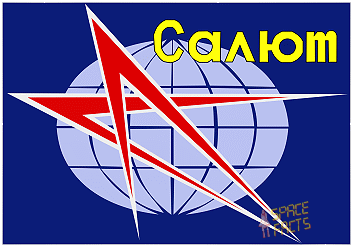 |
![]()
Launch, orbit and landing data
walkout photo |
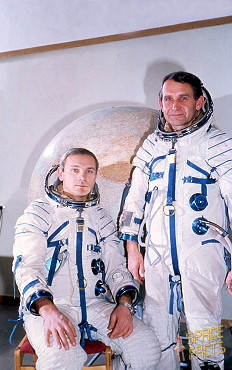 |
|||||||||||||||||||||||||||||||
alternative crew photo |
alternative crew photo |
|||||||||||||||||||||||||||||||
alternative crew photo |
alternative crew photo |
|||||||||||||||||||||||||||||||
alternative crew photo |
alternative crew photo |
|||||||||||||||||||||||||||||||
Crew
| No. | Surname | Given names | Position | Flight No. | Duration | Orbits | |
| 1 | Dzhanibekov | Vladimir Aleksandrovich | Commander | 1 | 5d 22h 58m 58s | 94 | |
| 2 | Makarov | Oleg Grigoriyevich | Flight Engineer | 2 | 5d 22h 58m 58s | 94 |
Crew seating arrangement
|
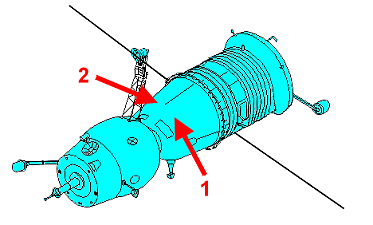 |
|
||||||||||||
Backup Crew
|
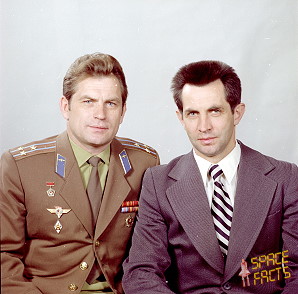 |
|||||||||||||||
Hardware
| Launch vehicle: | Soyuz-U (No. D15000-106) |
| Spacecraft: | Soyuz 27 (7K-T No. 44) |
Flight
|
Launch from the Baikonur Cosmodrome and
landing with Soyuz 26 capsule 166 km
northeast of Arkalyk.
Soyuz 27 landed 118 km north of Arkalyk. The main goal of the mission was to swap Soyuz craft with the orbiting crew. The Salyut 6 station required refueling by mid-January 1978, and this was to be accomplished by a new unmanned supply tanker, Progress. But the tanker had to dock at the aft port where the propellant line connections were, and Soyuz 26 was docked there. Mission control was not yet willing to attempt to redock the Soyuz at the other port, a now-standard practice. Accordingly, a new crew was sent up on another Soyuz spacecraft to dock at the forward port, and depart in the parked Soyuz 26 spacecraft. On January 11, 1978 Soyuz 27 docked without incident at the front port carrying cosmonauts Oleg Makarov and Vladimir Dzhanibekov, who formed the first visiting crew in the Soviet space station program (or, for that matter, in any space station program). Vladimir Dzhanibekov noticed that as he and Oleg Makarov approached the station in Soyuz 27, they were slightly off-course, but he allowed the automatic system to continue and, with 7 meters (23 ft) to go, it corrected the slight alignment error. To the relief of mission control, Soyuz 27 successfully docked at the forward port. For the docking, the first resident crew withdrew to their Soyuz 26 spacecraft and sealed the hatch into Salyut 6 behind them. This was done in the event of a depressurization emergency associated with the docking of Soyuz 27. The Soyuz 27 crew then encountered their first problem - a balky hatch that opened suddenly and sent Vladimir Dzhanibekov and Oleg Makarov tumbling backwards. The Salyut crew dove into the Soyuz and hugged their first visitors. There was also some concern that stresses and vibrations produced when the 7-ton Soyuz 27 spacecraft contacted the front port might transmit through Salyut 6, forcibly uncoupling Soyuz 26 from the rear port. The Soyuz 27-Salyut 6-Soyuz 26 combination massed about 33,000 kg and featured seven compartments: two descent modules, two orbital modules, the transfer compartment, the work compartment, and the small aft intermediate compartment. The four cosmonauts conducted many experiments, including Rezonans, which was designed to determine if resonant frequencies might threaten the structural integrity of the three-spacecraft combination. The experiment called for the cosmonauts to jump around Salyut 6 on command from the TsUP. The guest crew spent 5 days on Salyut 6, then returned to Earth in Soyuz 26, leaving the fresh Soyuz 27 spacecraft for the first resident crew. This was the first of many such spacecraft swaps. The visiting crew brought supplies such as food, books and letters, equipment and a French biological experiment called "Cytos", and Vladimir Dzhanibekov, an electronics expert, inspected the station's electrical system. On January 13, 1978 the crews performed for the first time the now-routine exchange of seat liners and centering weights in their respective Soyuz craft. The liners are custom molded for each space traveler, and are needed for launch and landing, and the weights are needed to ensure a proper center of mass for the returning craft so it does not undershoot or overshoot the landing target. While the main reason for the Soyuz swap was to free the aft port for the Progress, another reason was that extended exposure to space of the vehicle leads to degradation of its engine and propellant seals. A now-standard experiment called "Rezonans" was carried out, which tested the stresses of the multi-spacecraft structure by simply having the cosmonauts jump up and down. Cosmonauts Vladimir Dzhanibekov and Oleg Makarov returned to Earth in the Soyuz 26 spacecraft after spending five days on the station. One piece of information that the visiting crew didn't immediately tell the station crew was that Georgi Grechko's father had died ten days earlier. Psychologists had decided such knowledge was not in the best interests of a cosmonaut spending several months in space. Oleg Makarov and Vladimir Dzhanibekov informed Commander Yuri Romanenko, however, who assumed the responsibility of telling Georgi Grechko when they landed. Years later, Georgi Grechko said in an interview that he also thought the decision was the right one. The four cosmonauts conducted many experiments, including Rezonans, which was designed to determine if resonant frequencies might threaten the structural integrity of the three spacecraft combination (Soyuz 26, Salyut 6 and Soyuz 27). Additional work were photography of the Earth surface, solar observation and astronomical experiments. The Soyuz spacecraft is composed of three elements attached end-to-end - the Orbital Module, the Descent Module and the Instrumentation/Propulsion Module. The crew occupied the central element, the Descent Module. The other two modules are jettisoned prior to re-entry. They burn up in the atmosphere, so only the Descent Module returned to Earth. The deorbit burn lasted 188 seconds. Having shed two-thirds of its mass, the Soyuz reached Entry Interface - a point 400,000 feet (121.9 kilometers) above the Earth, where friction due to the thickening atmosphere began to heat its outer surfaces. With only 23 minutes left before it lands on the grassy plains of central Asia, attention in the module turned to slowing its rate of descent. Eight minutes later, the spacecraft was streaking through the sky at a rate of 755 feet (230 meters) per second. Before it touched down, its speed slowed to only 5 feet (1.5 meter) per second, and it lands at an even lower speed than that. Several onboard features ensure that the vehicle and crew land safely and in relative comfort. Four parachutes, deployed 15 minutes before landing, dramatically slowed the vehicle's rate of descent. Two pilot parachutes were the first to be released, and a drogue chute attached to the second one followed immediately after. The drogue, measuring 24 square meters (258 square feet) in area, slowed the rate of descent from 755 feet (230 meters) per second to 262 feet (80 meters) per second. The main parachute was the last to emerge. It is the largest chute, with a surface area of 10,764 square feet (1,000 square meters). Its harnesses shifted the vehicle's attitude to a 30-degree angle relative to the ground, dissipating heat, and then shifted it again to a straight vertical descent prior to landing. The main chute slowed the Soyuz to a descent rate of only 24 feet (7.3 meters) per second, which is still too fast for a comfortable landing. One second before touchdown, two sets of three small engines on the bottom of the vehicle fired, slowing the vehicle to soften the landing. |
Photos / Graphics
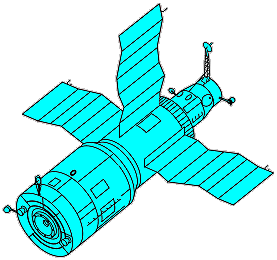 |
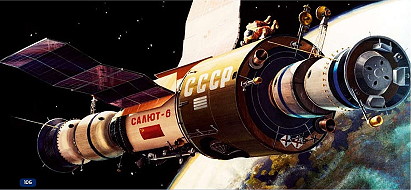 |
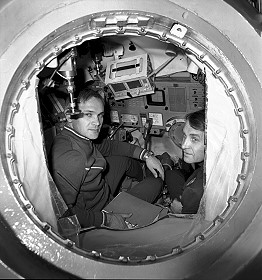 |
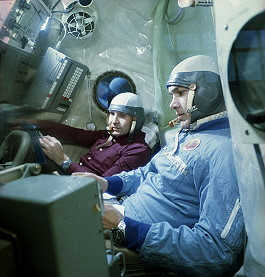 |
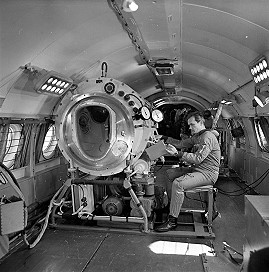 |
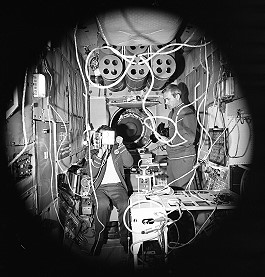 |
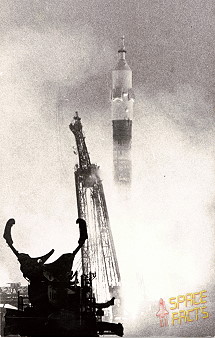 |
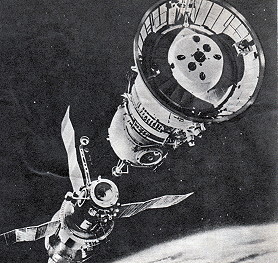 |
 |
 |
 |
 |
 |
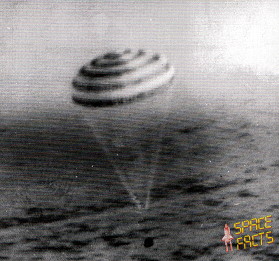 |
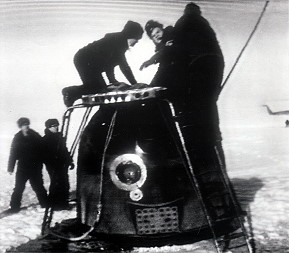 |
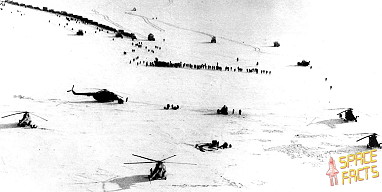 |
| © |  |
Last update on March 27, 2025.  |
 |